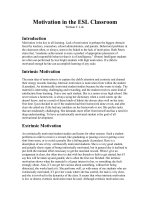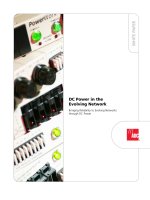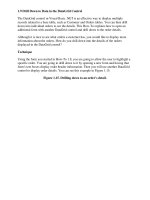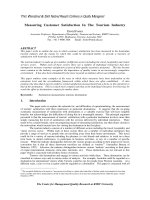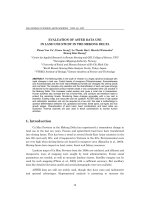Using Music in the ESL Classroom pptx
Bạn đang xem bản rút gọn của tài liệu. Xem và tải ngay bản đầy đủ của tài liệu tại đây (321.48 KB, 14 trang )
Using Music in the ESL Classroom
Thứ Năm, 03/06/2010, 02:36 CH | Lượt xem: 299
When students make a major
breakthrough in learning, it is music to a
teacher's ears. There is nothing more
rewarding for a teacher, than seeing their students
smile and laugh while they learn. The same can be
said for students. Students who are taught in a fun
and creative way, love coming to class. Using music
in the classroom is a great way for teachers to
achieve success with L2 learners. Oliver Wendall
Holmes suggests taking a musical bath once a week,
saying that music is "to the soul what water is to the
body."
Music is the universal language of mankind.
Henry Wadsworth Longfellow
Benefits of using Music
Have you ever heard of anyone who doesn't like
music? Some people may not like art, dancing,
reading, or movies, but almost everyone likes one
kind of music or another. Most people like many
different kinds of music. Studies have shown that
music
1.improves concentration
2.improves memory
3.brings a sense of community to a group
4.motivates learning
5.relaxes people who are overwhelmed or
stressed
6.makes learning fun
7.helps people absorb material
"Music stabilizes mental, physical and emotional
rhythms to attain a state of deep concentration and
focus in which large amounts of content information
can be processed and learned." Chris Brewer, Music
and Learning
Techniques for Using Music with L2 Learners
There are a variety of different ways to use music in
the classroom. Some teachers prefer to use
background music and others use music lyrics as the
basis of a lesson. Music can be used to:
1.introduce a new theme or topic
(Christmas/colours/feelings)
2.break the ice in a class where students don't
know each other or are having difficulty
communicating
3.change the mood (liven things up or calm
things down)
4.teach and build vocabulary and idioms
5.review material (background music improves
memory)
6.teach pronunciation and intonation
7.teach songs and rhymes about difficult
grammar and spelling rules that need to be
memorized ("i before e", irregular verbs, phrasal
verbs)
8.teach reading comprehension
9.inspire a class discussion
10.teach listening for details and gist
Suggested Activities
Many teachers try using music once in the class, but
forget to do it again. It might take a few times before
you and your class get used to hearing music while
learning. If you can commit to using music once a
week, you may soon see the benefits, and realize that
you want to do it more often and in a variety of ways.
Here are 10 activities for you to try:
1. Use background music such as classical, Celtic
music or natural sounds to inspire creativity
2. Teach your national anthem
3. Teach a song that uses slang expressions ("I
heard it through the Grape Vine")
4. Teach a song that uses a new tense you have
introduced
5. Add variety to your reading comprehension
lesson. Students can read lyrics and search for main
idea, theme, details.
6. Teach Christmas vocabulary through traditional
carols
7. Write or choose a classroom theme song
8. Create (or use already prepared lessons) cloze
exercises using popular song lyrics
9. Create variations to familiar songs by making
them personal for your class members or your lesson
10. Have "lyp sync" contests. Allow students to
choose their own songs. A little competition goes a
long way in the classroom. Have groups explain the
lyrics of their song before or after they perform.
"When the music changes so, so does the dance."
African proverb.
Teaching Kids with Music
Using music with ESL kids has all of the same
benefits mentioned above and more. Children are
natural music lovers. You don't have to convince
them that it will help them learn. If you feel
uncomfortable singing in front of the class to teach a
song, use a tape or CD player. (Don't expect your
students to sing if you don't. Remember, that they
don't care about the quality of your singing voice, just
like you don't care about theirs.) Here are some
suggested activities to use with kids (If you are not
familiar with any of the songs mentioned, simply put
the titles into an online search):
Transition songs: Teach simple songs that
indicate transitions from one activity to another, such
as "clean up" songs and "hello/goodbye" songs.
Energy boosters: Teach simple action songs
that require kids to stand up and move around. Think
of traditional birthday games that use songs, such as
pass the parcel (use a classroom mascot or other
favourite item instead of a gift) or musical chairs.
Animal songs: Children love learning about
animals! Teach animals and animal sounds using
repetitive songs like "Old McDonald had a Farm" and
"There was an Old Lady who swallowed a fly."
Multi-culturalism: Teach about multi-cultural
instruments and learn how to create them in class.
Remembering Names: Help students remember
names of their classmates (this helps teachers too)
with songs like "Willoughby Wallaby Woo."
Alphabet songs: Use lots of different alphabet
songs (not just the traditional ABC) to help kids
remember them in English. Chicka Chicka Boom
Boom by Bill Martin Jr and John Archambault is a
catchy children's book and song.
Colours: Teach the colours with various colour
songs and rhythms, such as Louis Armstrong's "What
a Wonderful World" or Kermit the Frog's "It aint
easy being green."
Rewards: Reward hard working kids with
"Music Time". Let them make requests for
background music that they can listen to while they
work on their written exercises.
Student teachers: Encourage the kids to teach
each other songs from their own language. Turn this
into an English lesson by having students translate
the meaning.
"Musical nourishment which is rich in vitamins is
essential for children." Zolton Kodaly
Tips for Using Music Effectively
When teaching students a song, it is a good idea
to introduce an instrumental version first (If an
instrumental version is not available, play the song
softly in the background while they are working on
something or hum the melody before introducing the
lyrics). If students become familiar with the sound of
the music first, they will be more likely to understand
the words.
Make a vocabulary list ahead of time. Go over
the words once before you introduce the song.
Expose students to a certain song many days in a
row. Within a few days, students will not be able to
get the song out of their head!
Choose interactive songs whenever possible.
Adding actions enhances language acquisition and
memory.
Have soft or upbeat music playing before class to
encourage a positive atmosphere. Turning the music
off is a great way to signal to a large class that it is
time to begin.
Online Materials and Resources
These online music resources offer numerous ideas
and tips for using music in the classroom.
Luna Nguyễn

